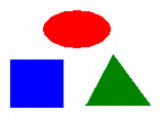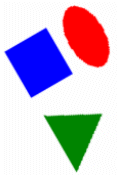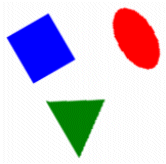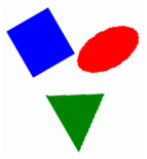
A group and its objects can be configured with any combination of movement (horizontal, vertical, and rotational). The following examples illustrate how some of these combinations work.
Example 1: Rotating the group and moving the object left to right
If your group is configured to rotate from 0 degrees to 60 degrees, and one of its objects is configured to move left and right, the object will do both. It will move left and right as per its own properties, and, at the same time, it will rotate as part of the group. Remember, however, that 'left' and 'right' are relative to the original orientation of the group, not the page. As the group rotates, 'horizontal' also rotates. When the group has rotated 15 degrees, 'left' is actually 285 degrees; (not 270 degrees), and 'right' is actually 105 degrees (not 90 degrees). When the group has rotated 50 degrees, 'left' is 320 degrees, and 'right' is 140 degrees, and so on.
Original state of group

Group rotated right, and ellipse moved left

Example 2: Rotating the group and moving the object up and down
If your group is configured to rotate from 0 degrees to 60 degrees, and one of its objects is configured to move up and down, the object will do both. It will move up and down as per its own properties, and, at the same time, it will rotate as part of the group. Remember, however, that 'up' and 'down' are relative to the original orientation of the group, not the page. As the group rotates, 'vertical' also rotates. When the group has rotated 15 degrees, 'up' is actually 15 degrees (not 0 degrees), and 'down' is actually 195 degrees (not 180 degrees). When the group has rotated 50 degrees, 'up' is 50 degrees, and 'down' is 230 degrees, and so on.
Original state of group

Group rotated right, and ellipse moved up

Example 3: Rotating the group clockwise and rotating the object anticlockwise
If your group is configured to rotate from 0 degrees-60 degrees, and one of its objects is configured to rotate from 90 degrees-0 degrees, the object will do both. It will rotate as per its own properties, and, at the same time, it will rotate as part of the group. Remember, however, that the object's rotation is relative to the group, not the page. If the group rotates 60 degrees to the right, and the object rotates 90 degrees to the left, the object has only rotated 30 degrees to the left relative to the page.
Original state of group

Group rotated clockwise, and ellipse rotated anticlockwise

Note: By moving the ellipse as shown in the above examples, you are actually changing the overall size of the group. It is important to remember this as it might affect object fill levels.
See Also